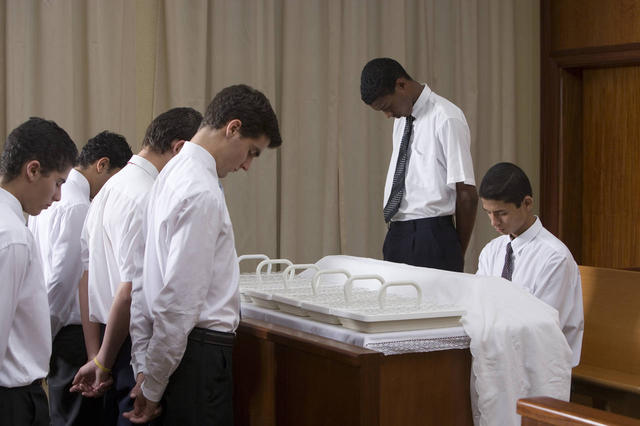Question
Gramps,
I am a primary teacher, and recently one of the presidency taught the children that it is necessary to partake of the sacrament with the right hand. I had never heard this until I moved here. I have also had a friend correct my “lefty” (who is 3) about using his right hand. I have looked and have found no information on this. I have limited resources, but what I have searched (Mormon Doctrine, Answers to tough gospel questions, as well as the scriptures and lesson manuals) have only supported what I feel, that it detracts from what we should be thinking about while partaking, i.e., the test to assure correct doctrine (Answers to tough Gospel questions). What is it’s purpose? Does it edify? Is it born of obscurity? Is it in harmony with scripture and the voice of our living prophets?
As far as I have found, it is obscure, has no purpose, is not in harmony with teachings, and has no edifying effect. Of course like I said, I have limited resources, and may very well be missing something. If it is something that has been taught by prophets or is in the scriptures, could you please tell me where to find it? I want to make sure I am teaching these children correct principles and doctrine, and not “Mormon Lore.” They have many difficulties ahead, and don’t want to confuse important issues. My sincere thanks for your help.
Anon
Answer
Dear Anon,
A lot of people in the Church are stuck on the preeminence of procedure. The Pharisees in the time of the Savior were sticklers for practicing the letter of the law. I assume that there is nothing the matter with that as long as the letter of the law does not replace the spirit of the law. I feel confident that the spirit and meaning of the sacrament is in no way invalidated by partaking of the elements with the left hand. It is, however, customary to partake with the right hand, and this custom is apparently interpreted by some as doctrine. Those who feel that this is a doctrinal matter are normally quite adamant about it, since to them it is a matter of doctrine.
The custom of taking the sacrament with the right hand relates to a matter of reverence and respect. The right hand has traditionally (from the earliest times) been associated with the more noble functions and the left hand with the more base. So intrinsic is this in the cultures of the world that in earlier languages the names for the right and left hands carried the significance of their functions. The word “right” in Greek is “ortho,” from where we get the word “orthodox.” It also means “straight” or “true,” from where we get the term “orthodontist,” or “tooth straightener, “donte” being “tooth.” The English word “right” comes from the Latin “rectus,” meaning “straight.” The English word “left” comes from the Old English, meaning “weak.” In Spanish the right hand is “la mano diestra” and the left is “la mano siniestra.” Our word, “dexterous” derives from “diestra” and our word “sinister” derives from “siniestra.” Even today in the English language, the term “left” or “left handed” denotes some degree of inferiority, implying clumsy, awkward, insincere, backhanded, or dubious.
So it is both proper and customary to partake of the sacrament with the right hand, and it would not be inappropriate to teach our children (when they are old enough to understand it) that partaking of the sacrament with the right hand is a matter of respect
Incidentally, I am also left handed, and have suffered through life as a member of the only oppressed minority that has no representation, no spokesman, no recognition and no rights. We struggle through life with the requirement to adapt to a right handed world. Although some accommodations are made when it is commercially advantageous, they are not always easy to come by. When I was a kid I liked to play baseball, but in our town there were no baseball gloves for lefthanders. So I had to wear the glove on my left hand to catch the ball, then slip it off under my right arm in order to free my left hand to throw the ball. In the first grade my teacher tried to force me to write with my right hand, rapping my knuckles with a ruler whenever she saw the pencil in my left hand. (By the way, did you know that there are no left handed pencils? Pick up a pencil or pen in your left hand and look at the inscription written along the side. It will always be upside down.)
Men’s shirts button from the right so that they must be buttoned with the right hand. The only reason why women’s blouses button on the left is that when buttons were first used they were very expensive, and the only women who could afford them had maids. So the buttons were put on the left side so that the maids could do them up with their right hands.
It is very difficult to find such implements as left handed scissors, butter knives and mustache cups. Virtually all wrist watches have the stems on the right side. Musical instruments, such as guitars and other stringed instruments, trombones and trumpets and the other brass instruments, to name a few, are all constructed for right handed people. The doors to public buildings are normally designed to accommodate right handed persons. The bolts on firearms are located on the right side. The computer mouse is designed for right handed people. Books and magazines open from the right, the pages to be turned by the right hand.
So your little three-year-old boy has some interesting challenges facing him as he grows up. Let’s hope that those challenges help him to be a non-conformist, to challenge conventionalism, to learn to adapt to unusual or difficult circumstances, and to recognize and be sympathetic to others in society who may be handicapped in one way or another.
Gramps






